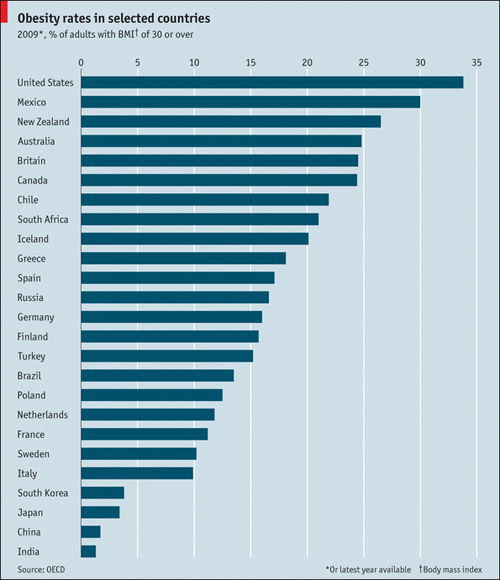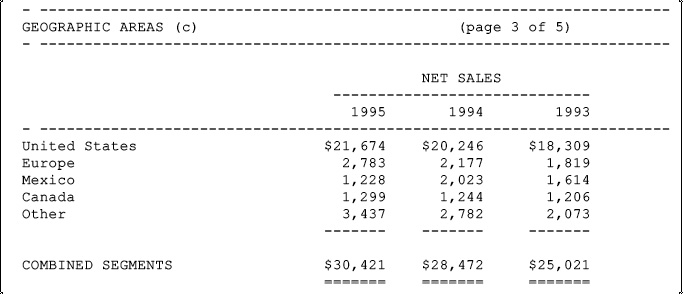PepsiCo Mexico

The Economist Obesity Rates in Selected Countries
It is becoming widely known that the United States is the fattest country in the world. Within one generation, our population’s body mass index (BMI) shows that those of us who are considered clinically overweight or obese has grown from 15% to 55% of total population. Similarly, 40% of USA death certificates list diabetes as a cause of death – up from 13% twenty years ago.
“global branded junk food companies have found a new metabolic donkey in the populations of the third world.”
The economic cost of this terrible health circumstance is staggering. The bill for US medical expenditures directly linked to obesity is running $147 billion annually – and this excludes loss of productivity due to comorbidities such as orthopedic problems, sleep apnea, gallstones, depression, and early death. The cluster of metabolic disorders that account for our declining health include obesity, type 2 diabetes, hypertension, lipid disorders and cardiovascular disease – all directly related to our recent adoption of processed foods – and also to our sedentary lifestyle. This salty, sugary footprint has companies such as PepsiCo, the biggest manufacturer of globally branded processed snack foods, (at minimum) partially responsible for the treasury of health consequences over the last twenty years.
It is no wonder that PepsiCo stock is up more than 10,000% since 1980. With breathless intensity, our society has embraced processed, branded food products at the expense of real food – often under the mantra of cost savings and convenience – only to realize the true cost is merely expanded upon and shifted onto society sometime in the future after profits are bonused and campaign contributions expended. What’s worse, much of this train wreck of death and disease is due to societal choice and preference – with the current costs rivaling smoking in terms of the devastation caused. At present, we are on track to nearly double the severity of these statistics in the next 20 years if nothing changes.
The rest of the world enjoys its tasty first bite of Western culture through the media – followed soon thereafter by our processed, branded junk food products. In no place is the urge to influence popular sentiment more enticing than in the third world where rising food cost can be a key ingredient to political unrest. Many developing countries share a special mix of growth (aspirational, transitional population), favorable legal contexts and a weak civil society that make replacing indigenous foods with processed, branded junk food both a rich prospect (private gain) and a political victory; yet what remains out of immediate view is the massive social loss in the form of health consequences. Along the Amazon, Nestle operates river barges (think Joseph Conrad) that ply the waters of far-away peoples in order to exploit the first opportunity to convert new economic pilgrims fresh out of the bush. Nestle and other food companies offer special smaller size SKUs (candy bars, yogurt, sugar cereals) suitable for enticing even the poorest people to alter consumption behavior. As such, obesity once associated with city dwellers is now appearing more frequently with people in rural areas who often have no access to health care.
Predictably, the World Health Organization (WHO) reports that the percentage of obese humans globally has doubled in the past twenty-eight years. The fatal social side-effects are clear: according to the Red Cross, for the first time in history, more people in the world are dying from over-consumption than from starvation.

Diabetes is Mexico’s Leading Cause of Death
Sensing a peak in unit growth and a potential for political backlash in Western countries, global branded junk food companies have found a new metabolic donkey in the populations of the third world. At play are billions of upwardly-mobile people who are emotionally and psychologically available to bear the burden of fantastic profit growth. After all, who better to exploit than people who equate freedom and upward mobility to novel junk food products? And among these billions of emerging consumers, children are the most susceptible to persuasion by Western executives thirsty for the prompt seizure of opportunity.
The roadmap outlined by junk food companies for third world exploitation reveals an affable, whistle-while-you-work attitude to what is nothing more than ever more automagical ways to engorge humanity with pathogenic processed food products. PepsiCo’s public annual reports illustrate Mexico as a major first target of opportunity more than 20 years ago. In fact, PepsiCo mentioned the word “Mexico” 118 times in its 1999 Annual Report. By comparison, the King James Bible uses the word “worship” 120 times.
With the stealthiness and precision of modern aerial drones, the Western marketing machines employed aggressive visual campaigns in Mexican schools and civic events unhindered by cultural or legal boundaries. Researcher Luis Gomez reports the beverage industry actively lobbied against Latin American efforts to regulate the marketing and accessibility of sweetened beverages and instead invested in superficial campaigns to promote physical activity – thereby inculcating the notion of self-blame in the obesity equation at the earliest possible opportunity.
PepsiCo’s 1996 annual report illustrates the world according to PepsiCo. Mexico’s importance to net sales appears to be on par as a category comparable to Europe and the other 198 or so countries of the world.

The World According to PepsiCo. Source: Pepsico Annual Report
The decline in Mexican net sales resulting from an economic crisis in the mid-1990s appears not to have hindered PepsiCo’s long-term objectives.
Predictably, the once bucolic Mexican health landscape has been eviscerated beyond recognition. In Mexico, according to Barry Popkin, an expert on food and diet in developing countries at the UNC School of Public Health, virtually no one was overweight 15 years ago; now 71 percent of Mexican women and 66 percent of men suffer from obesity. Mexicans drink more soft drinks than people in any other country. Today, diabetes is the leading cause of death making it the global leader in disease rates for diabetes – a non-communicable disease! In a superlative case study for the double helix of demographic and geographic marketing segmentation, the junk food merchants can claim that Mexico now has the highest rate of childhood obesity in the world. Folks, this is millions of human life-years sacrificed at junk food’s alter in Mexico alone.

Mexico Ranks First for Global Coca Cola Consumption
The bonanza of opportunity in Mexico that was proven up by PepsiCo’s tenacity and commercial acuity didn’t escape notice of its chief rival, Coca Cola. Coca Cola reports Mexico leads the world in per capita consumption of its sugary drinks.
The free-wheeling spirit of imagination in PepsiCo’s marketing department envisions the whole of developing country humanity mimicking Mexico’s stupendous result in terms of market opportunity. In other words, Mexico is the gold standard.

PepsiCo Mexico. Source: PepsiCo Presentation 2013
The Spanish Flu or influenza pandemic is the deadliest natural disaster in human history, estimated to have killed between 3-5% of the world’s population between 1918-1920. The term Spanish Flu came about due to Spain’s neutrality during World War I, which left its media relatively uncensored. Wartime sensors in other Western countries suppressed negative news about the virus in a mistaken belief that information suppression would magically make the virus less virulent. The opposite occurred, and Spain’s media coverage created the false impression that the virus was more active in Spain.
Another nuance to the Spanish Flu was the devastation caused to remote peoples with relatively naïve immune systems. In turns out that people in connected parts of the world (mostly Western city dwellers) gained some immunity advantage by being exposed to earlier versions of the flu virus. The parallels to the current pandemic threat from global junk food are powerful – except that this virus is even more deadly.
The global junk food merchants would have you believe that changing course is infringing on the principal of commercial freedom. I equate this to believing that deadly viruses should be protected from eradication because we share a common existential condition called life. Merely sharing a common condition called life does not mean viruses should be left to run free at the expense of human life. So what are we to do with this pandemic virus?
Sources:
World Health Organization
PepsiCo
Coca Cola Company
Fat Chance by Dr. Robert Lustig
“Sponsorship of Physical Activity Programs by the Sweetened Beverage Industry: Public Health or Public Relations?” by Gomez, Luis, et al.
by Simons Chase – SIMONSCHASE.CO
Very interesting post, it shows how things are changed over the last 15-20 years around Mexican food and beverage habits, starting in 2010 the government prohibited to sell sodas/sugar beverages and salty snacks in mexican elementary schools in order to fight the obesity problem, some info (in spanish) http://www.eluniversal.com.mx/nacion/177992.html
Fu..ck you American Corps.. You are killing México!